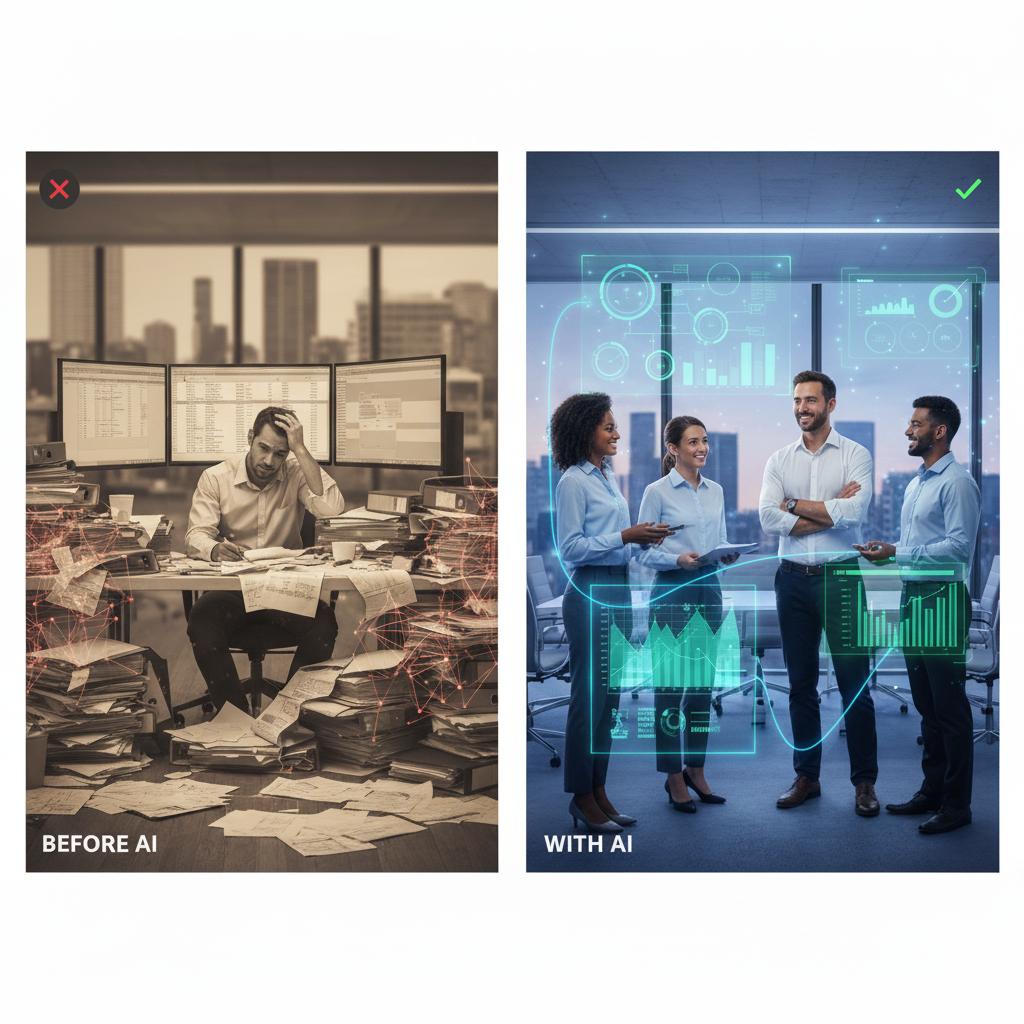Students Already Use AI. Now Make It Visible.
How transparency raises standards, reduces disputes, and prepares students for professional work.
8 min read
.jpeg) Robert Barrett
:
Sep 23, 2025 12:27:06 PM
Robert Barrett
:
Sep 23, 2025 12:27:06 PM
.png)
Table of Contents
A RightSeat White Paper
For decades, governments have invested in digital solutions, yet citizens continue to feel lost in a sea of bureaucracy. This frustration erodes public trust and represents a clear disconnect between intent and impact. While digital initiatives have made services available, the next frontier is to make them personal, proactive, and human.
AI offers a path to bridge this gap. Beyond simple automation, it can deliver more accessible, equitable, and transparent services by understanding natural language, anticipating needs, and tailoring information. However, successful AI adoption in the public sector requires navigating unique challenges, including outdated procurement, complex legacy systems, and talent shortages.
At RightSeat, we believe AI's purpose in government is to serve people. We call this vision AI as a Public Servant, and it guides our approach in three ways: we prioritize Citizen-Centered Design, apply Pragmatic Implementation, and measure success by Measurable Impact.
To help leaders get started, we recommend three strategic first steps:
RightSeat is the trusted co-pilot for this journey. We translate complex AI mandates into clear, mission-focused action plans, helping agencies move from fragmented projects to integrated, strategic solutions that deliver tangible results for citizens.
Governments have poured billions into digital portals, forms, and apps. Yet, for most citizens, the experience remains frustrating: long wait times, confusing systems, and a feeling of being lost in bureaucracy. This gap isn't just an inconvenience; it erodes public trust. A 2024 study by the American Customer Satisfaction Index (ACSI) found that while citizen satisfaction with federal services has improved, it still lags far behind leading commercial sectors. The next frontier for many agencies isn't simply about being "digital"; it is about becoming truly personal, meeting each citizen where they are in a way that is clear, trustworthy, fair, and human.
AI brings new capabilities that go beyond simple digitization. Natural language understanding lets citizens ask questions in their own words and get accurate guidance. Predictive models can anticipate when a citizen needs help, such as reminding families about benefit renewals. Personalization engines can tailor information to a person's specific situation, reducing irrelevant steps and saving time. AI assistants can also make complex regulations easier to understand, summarizing eligibility rules or explaining next steps.
This is a foundational shift. Done well, AI helps agencies move from passive systems, where citizens must navigate complex forms, to proactive services that anticipate needs and meet people where they are.
But the promise comes with risks. Poorly designed AI can deepen inequities, create confusion, or erode trust if citizens feel they are dealing with a black box. That is why responsible design and human oversight are central to this effort.
While AI's potential is significant, successful deployment requires navigating real constraints that private sector organizations rarely face. Federal agencies have experienced a widening gap in adopting AI and modernizing technology, largely due to bureaucracy and outdated procurement. Leaders must address several key challenges:
Secure Access: Government agencies handle vast amounts of sensitive and classified data. Implementing AI requires robust systems to ensure only authorized personnel can access or interact with specific data. Unlike the private sector, government must manage a complex web of security clearances and need-to-know restrictions, making authentication far more complex.
Legal and Regulatory Constraints: Agencies must comply with extensive requirements, including data privacy and accessibility standards, that can significantly slow adoption. Unlike private companies, government can't simply test and iterate. They must ensure compliance from day one.
Legacy System Integration: Most agencies run on decades-old infrastructure. Integrating AI with these legacy systems requires careful planning and often complete system overhauls.
Talent Shortages: Agencies face a unique hiring challenge. The pace of technology outstrips the speed of federal recruitment, and the demand for cleared, AI-literate experts far exceeds the supply. This creates a strategic talent gap that slows down progress. Rather than waiting, leaders can work with specialized partners who provide access to vetted, mission-aligned talent, enabling them to build and deploy solutions without sacrificing compliance or continuity.
Procurement Complexity: Federal acquisition can take months or years, while AI technology evolves rapidly. Furthermore, government leaders often feel they lack leverage, as vendors sometimes withhold critical information about their AI systems.
Change Management: Staff need training and reassurance about their evolving roles. Unlike private sector implementations, government AI projects must address workforce concerns within union structures and civil service protections.
The promise of government AI isn't theoretical. Real agencies are delivering tangible results for citizens today.
These successes share common elements: they focus on high-impact citizen services, maintain human oversight, and measure outcomes rigorously. Internationally, Estonia's digital government services achieve a near-100% digital interaction rate, while Singapore's government chatbots handle over 80% of citizen inquiries without human intervention. Denmark uses predictive analytics to proactively identify citizens at risk of homelessness and connect them with support services.
While other countries have achieved notable successes with centralized approaches, the U.S. faces unique implementation challenges. Our federal system creates coordination complexity across multiple levels of government. The Federal AI Use Case Inventory shows that over 1,700 AI applications across agencies are already operating. However, this also reveals challenges, including the lack of a common definition of AI, limited internal capacity to evaluate AI systems, and insufficient monitoring of contracts. Congressional oversight and media scrutiny mean that any AI failure becomes a public issue, creating risk aversion.
This is a reality few traditional tech vendors understand. At RightSeat, we are the co-pilot for this journey. We translate complex federal AI mandates into clear, mission-focused action plans, helping agencies move from fragmented pilot projects to integrated, strategic solutions. We work alongside leaders to build the practical governance and oversight that earns public trust, allowing them to focus on delivering tangible results for citizens.
At RightSeat, we believe AI in government is not about shiny tools or chasing hype. It is about the fundamental purpose of serving citizens. Done responsibly, AI can make services easier to access for everyone, regardless of literacy, language, or disability. It can deliver more equitable outcomes and anticipate citizen needs instead of waiting for crises. It can strengthen trust by being transparent, explainable, and human-guided.
We call this AI as a Public Servant. Our purpose is to ensure technology serves people, not the other way around. Our approach differs from traditional government IT vendors in three key ways:
For agencies considering how to apply AI responsibly, three starting points stand out:
By focusing small, engaging people, and building trust early, agencies can set themselves up for bigger wins.
The promise of AI in government isn't about replacing public servants. It is about amplifying what makes them effective: their ability to listen, adapt, and serve with empathy. Wisconsin's success shows that when AI is designed with human oversight, clear objectives, and a citizen focus, it can transform how government serves people. If AI helps one more family access healthcare, one more veteran receive timely support, or one more citizen feel respected by their government, then it isn't just a technology investment. It is a purpose fulfilled.
The path forward requires acknowledging both the tremendous potential and the real implementation challenges. Success depends on starting with citizen needs, building with transparency, and measuring impact by human outcomes. For government leaders ready to take this journey, the question is not whether AI will transform public service, but whether your agency will lead or follow that transformation.
Sources
Add your email below and we'll send you newsletters and blog updates from the RightSeat AI TrustLab

How transparency raises standards, reduces disputes, and prepares students for professional work.

Part 2: AI for Strategic Planning

AI for Strategic Planning, Part 1